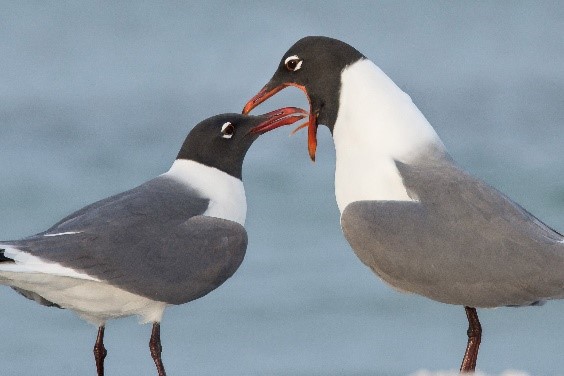Description

Disclaimer: Copyright infringement not intended.
Context
- Laughing gull, a migratory bird from North America, has been sighted for the first time in India at the Chittari estuary in Kasaragod district.
Laughing Gull (Leucophaeus atricilla):
Physical Characteristics:
- Size: Medium-sized gull, with a length of around 16 to 18 inches.
- Plumage: During breeding season, adults have a black head, dark-gray wings, and a reddish bill. Non-breeding adults and juveniles have a mottled brownish-gray appearance.
- Distinctive Features: Black or dark hood during breeding, and a long, slender, slightly drooping bill.
Habitat:
- Breeding: Coastal marshes, islands, and beaches in the southern United States, Mexico, the Caribbean, and parts of Central America.
- Wintering: Along coasts, estuaries, and lagoons.
Behavior:
- Vocalization: Known for its distinctive "laughing" calls, resembling a high-pitched "ha-ha-ha."
- Feeding: Opportunistic feeder, preying on small fish, invertebrates, and scavenging on scraps and refuse.

Breeding and Nesting:
- Colonial Nesters: Laughing gulls nest in colonies, often in close proximity to other seabirds.
- Nesting Sites: Nest on the ground in shallow scrapes lined with grass, feathers, and other debris.
- Eggs: Clutches typically consist of three eggs with incubation lasting about three weeks.
Migration:
- Laughing gulls exhibit migratory behavior, with some populations migrating between breeding and wintering grounds.
Distribution:
- Found along the Atlantic and Gulf coasts of North America, extending into the Caribbean and parts of Central America.
Conservation Status:
- Least Concern (LC) on the IUCN Red List, as the species has a large and stable population
Interactions with Humans:
- Often encountered in coastal areas, including beaches, where they may interact with beachgoers.
- Known to be bold in scavenging for food from humans.
Role in Ecosystem:
- Plays a role in controlling insect populations and participating in nutrient cycling in coastal ecosystems.
Protection and Conservation:
- Protected under various conservation laws in different regions to ensure the preservation of their habitats.
|
PRACTICE QUESTION
Q. Consider the following statements regarding the Laughing Gull (Leucophaeus atricilla):
- It is a large-sized gull species with predominantly black plumage during the breeding season.
- The Laughing Gull is known for its distinct "laughing" vocalizations.
- During the non-breeding season, adults and juveniles of the Laughing Gull display a mottled brownish-gray appearance.
- This species primarily breeds in inland forests.
Which of the statements above is/are correct?
A)1 and 2
B) 2 and 3
C) 1, 2, and 3
D) 4 only
Answer: B) 2 and 3
Explanation:
- The Laughing Gull is a medium-sized gull species, not large-sized.
- Correct. The Laughing Gull is known for its distinctive "laughing" vocalizations.
- Correct. During the non-breeding season, adults and juveniles have a mottled brownish-gray appearance.
- Incorrect. The Laughing Gull primarily breeds in coastal marshes, islands, and beaches, not inland forests.
|














